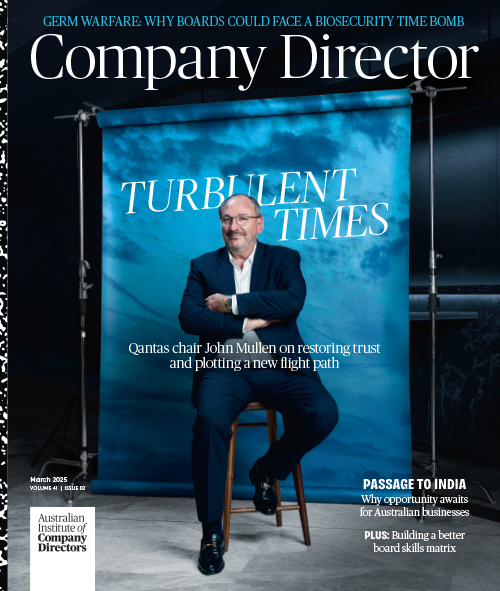Transgrid chair Jerry Maycock FAICD believes CEOs need to be more collaborative than they were in the past — with staff, stakeholders and their boards.
“The lone wolf CEO who runs the company with charisma and an iron fist? That’s a hard model to sustain. It’s all about acquiring the best team around you and making sure you effectively delegate,” says Transgrid chair Jerry Maycock FAICD, who also believes that a good team can provide the CEO with more bandwidth to deal with problems.
Maycock was recently awarded the AICD 2022 Queensland Gold Medal for his contribution to Queensland corporate and community life. As well as being the chair of the high-voltage electricity management company, he is also a director of children’s education charity The Smith Family, with a decade’s service.
Beginning his career with Shell Oil in the UK, Maycock went on to hold a number of senior management positions in Australia, New Zealand and Asia, principally with Holcim, a Swiss multinational sustainable building materials manufacturer. The last of his senior management roles was as CSR managing director and CEO, and he has since continued to work as a non-executive director, using his expertise and international experience in governance, operational management and corporate leadership. He was previously chair of both AGL Energy and the former mining and materials company Arrium.
Maycock draws on his experience as an executive and director to provide a perspective on how CEOs can succeed in the current environment, in which there is a broader range of stakeholders and greater regulation and political involvement in markets. There is also more shareholder activism and a greater emphasis on accountability for company directors. He believes there is an expectation amongst some observers, shareholders, government representatives and sections of the media that all directors are somehow across every aspect of a company’s performance. While this isn’t possible, it does mean that chief executives need to work more closely with the board and directors are more hands-on than previously.
The need for a smart strategy
CEOs need to have a simple, realistic and pragmatic strategy, which will resonate with internal and external audiences. If they can’t articulate this strategy, it’s very hard for CEOs to take the company, employees and external stakeholders with them.
“The way chief executives and senior executives relate to their staff, their middle management — it has to be much more engaging,” says Maycock. “Much more sense of purpose, much more sense of values. They want to feel that they’re working for the right cause.”
Maycock says the values a CEO brings to an organisation are critical, and it’s hard for CEOs who don’t live the values to survive. “With social media and things like whistleblower protection legislation, there’s nowhere to hide. It’s impossible for CEOs to control the narrative entirely. If there’s bad behaviour going on and if you’re not living up to the values espoused for the organisation, you will get outed.”
Risk management has to move beyond a “tick and flick” model to become embedded in the organisation to deal with new threats such as cyberattacks and pandemics. Senior and middle managers have to understand why risk management is important, why they should contribute and how it goes beyond financial risks.
The basic skills a CEO has always needed — such as commercial astuteness and strategic competence — are no less important, but there are a host of additional attributes required today. They need to be adept communicators, to be authentic and to have a degree of humility, as well as resilience and perseverance.
CEOs also need to possess the courage to uphold values, because it’s tough to make calls around some of the softer issues.
“If the CEO is not courageous, then they just let things go,” says Maycock. It’s the old story of how it’s what you walk past that sets the standard. The better CEOs know a problem when they see it and don’t hide from it. They run up to it.”
Working with the board
In terms of how the CEO should work with directors, Maycock says that first and foremost, transparency and openness are critical to maintaining trust with the board — and that’s a two-way street. This requires more regular and more forceful communication than may have been needed in the past.
When something goes wrong, CEOs should deliver the bad news to the board and be accountable. Maycock says he has been in many board meetings where the CEO outlines a problem, and after a few seconds of absorbing the bad news, the board usually wants to know how it can help.
By the same token, CEOs who arrive at a boardroom without some sort of solution, are a pet hate. “I don’t like CEOs who just bring the board problems or a series of options without a preferred solution — that’s very annoying. It immediately puts the board into solution mode without all the data,” he says, adding it makes the board uncomfortable because they worry the CEO will blame them if the solution they advise doesn’t work out.
Maycock tells executives that if they don’t have a fully fledged solution, it’s okay to show up to a meeting with a directional solution or one they want to road test with the board.
Notwithstanding that the CEO and board need to work more closely together, they still have to respect each other’s roles. Maycock believes CEOs need to respect the fact that directors have this suite of responsibilities and have a bona fide need for information.
Latest news
Already a member?
Login to view this content



